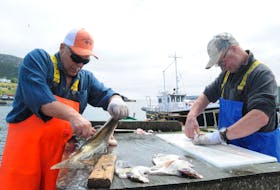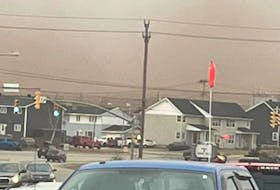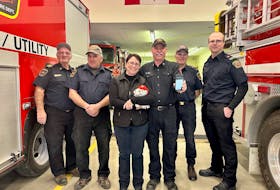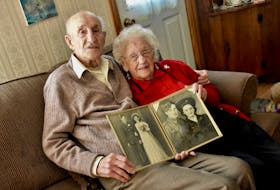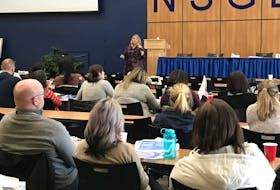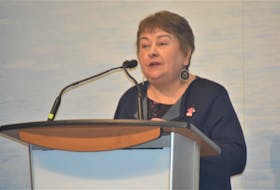They were innocent, fresh-faced rural kids not far removed from school, the sons of farmers, fishermen and miners.
And the big, wide world beckoned.
“It was a big deal when you are 16, 17 or 18, and you were going to Europe, you were going to see London,” said Ray Coulson, curator of the North Nova Scotia Highlanders Regimental Museum located in the armoury building in Amherst.
Shipping out

In mid-1941, more than 1,000 members of the North Nova Scotia Highlanders infantry regiment, an amalgam of military companies from Northern Nova Scotia, shipped out for England.
Many of them did get to see London but the bulk of the bright-eyed North Novies who charged onto Juno Beach and stayed the course for the weeks-long Normandy Invasion and beyond, saw more blood, death and carnage than they ever could have imagined during basic training at the Col. James Layton Raslton Armoury near Nova Scotia’s western border.
The initial deployment overseas led to almost three years of intense drills at locations across the British Isles, including rigorous battle exercises in the hills and lochs north of Fort William in Scotland.
The first taste of active combat for the 1,000-plus North Nova troops was the Allied D-Day invasion. Fewer than 100 of the men who shipped out for England in the initial foray from the Amherst garrison returned without some kind of physical combat injury.
Recruits continued to train at the Amherst armoury throughout the war in anticipation of deployment overseas and there were more than 1,700 wartime casualties among the North Novies. Many of those injured were patched up at military hospitals and sent back into battle. Only the severely wounded were shipped back home to Canada.
Young men who made the ultimate sacrifice

By the time the fighting finally stopped in 1945, there were 486 North Nova Scotia Highlanders killed overseas.
The average age of the North Novies who fell in battle was just 19.
“The pressure was there to recruit,” said Coulson. “You are in school and your buddies join, you have to join.”
The North Nova Highlanders were immediately placed on active service at the onset of war, in September 1939.
“The men who were interested in joining started flocking to the armouries to sign up,” Coulson said. “Right from the very beginning from the first days of the war, this place was receiving recruits and signing up.
“What attracted a lot of them, the war was supposed to be over by December.”
The Baillie brothers
These were men of humble, ordinary origin but they were not ordinary men. They were men like the Baillie brothers from Pictou County, William Angus (Bill) and John Daniel (Don). The Baillie brothers had been working at the O’Brien gold mine in the Abitibi region of northwestern, Que., near what is now Rouyn-Noranda, in the early days of the Second World War.
When the mine shut down, the brothers took the train home to Nova Scotia to return to the family farm in Welsford, a community near River John. When the train stopped in Truro, the brothers decided to enlist in the military with the North Novas, then a reserve unit.
“They had no idea what they were doing, what they were getting themselves into,” said Brian Baillie, Bill’s son. “It seemed like a good idea at the time.”
The brothers, 24 and 22 when they enlisted, did their basic training at the armoury in Amherst before being dispatched to England. Both moved up the ranks during training and Bill was a sergeant major by the time they saw their first combat during the D-Day invasion of Normandy.
Don Baillie was hit by mortar on June 7, 1944, after he reclaimed a Bren gun carrier that his troop had earlier left behind a barn in the village of Authie, about 20 kilometres inland from the Juno Beach landing they had made the previous day. The gun carrier was hit and Don Baillie died a week later.
Don Baillie was one of 5,000 Canadian soldiers who were lost in more than two months of fighting in the Battle of Normandy, 359 of whom died on the first day, D-Day. More than 13,000 Canadian soldiers were wounded during the Normandy campaign.
Bill Baillie served with distinction until the war’s end and added an honorary citizenship of Authie award to his military medals for having founded the Children of Authie Fund in memory of fallen comrades during the war. The elementary school in Authie bears his name. Bill Baillie died in 2002.
In post-war days, Baillie was a member of the North Novas memory club that met monthly at the armoury in Amherst. Coulson, 82, and a retired sergeant major with the Novas, was secretary of the memory club.
“I admired those guys so much, what they went through and how they carried themselves,” Coulson said. “I just thought their history can’t be lost. There were a lot of artifacts around back then. They started bringing them in and we started the museum back in 1986.”
Amherst armory honours the North Novies' sacrifice
While the fate of the armoury building has stood on shaky ground for the past number of years, the significance of the museum message remains. Uniforms, weapons, an honour roll and a bevy of stories and photos are packed into the second storey of the armoury.
“It’s the old story,” Coulson said. “You never have enough room and you never have enough money. A lot of people still come in, a lot of school kids.”
When they do, Coulson shares tales about people and wartime events, like the account of Carl Gambel, an infantryman from Debert who had a leg blown off by a landmine in Europe before being sent home.
“Several years later, his wife noticed something protruding out of the back of his neck, about the size of a toonie. Lo and behold, they took out a piece of shrapnel, out of his neck. That was in there all those years.”
Coulson shares the history of the Baillie school, the murders of 20 Canadian soldiers at Abbaye d’Ardenne, near Authie, letters from injured soldiers to nurses thanking them for their care and the dreaded Second World War telegrams.
RELATED: 12 North Nova Scotia Highlanders murdered at Abbaye d’Ardenne
“During the war, the wives and the families were home,” Coulson said. “One of the worst things they could see was a telegram boy coming down their street. That meant he was looking for a family and he had a telegram about their loved one being injured or killed or missing in action. There were a lot of these telegrams. It must have been something to go to the door knowing the telegram boy was there and knowing your husband was overseas. It was very stressful for the families at the time.”
Many of the North Novas, including Bill Baillie, downplayed their contributions to the successful Allied victory.
RELATED: Why a school in France is named for a Pictou soldier
Brian Baillie said his mother, Frances Lawrence, whom his father met while on leave near Falkirk, Scotland, would say that Bill Baillie talked fondly about his platoon, Company B, and the North Novas.
They weren’t all angels and they weren’t all heroes, but there were angels and heroes with them, Baillie said.
“My mother would say that, that’s how they described themselves. They weren’t all angels but there were some very brave men.”
D-DAY AT 75: Remembering the heroes and sacrifices of Atlantic Canada:
- VIDEO: The road to D-Day
- Why a school in France is named for a Pictou soldier
- U-boat hunter Roderick Deon returns to Juno Beach for D-Day
- Sound of gunfire rang in P.E.I. soldier’s ears
- North Nova Scotia Highlanders at the sharp end of D-Day invasion
- STORY MAP: Follow the D-Day experience of the North Nova Scotia Highlanders
- 12 North Nova Scotia Highlanders murdered at Abbaye d’Ardenne
- ‘It was noisy as the devil,’ says St. John’s torpedo man
- 59th Newfoundland Heavy Regiment was eager to do its part
- A P.E.I. dispatcher’s long, uncertain journey to Normandy
- LAURENT LE PIERRÈS: D-Day invasion was best birthday present for my Dad
- ‘Sight of our boys being blown up ... wouldn’t leave my mind:’ Bedford veteran, author
- Dartmouth veteran's first combat mission was D-Day invasion
- Halifax air gunner had bird’s-eye view of D-Day
- ‘We had everything fired at us but the galley sink’: Yarmouth County veterans share war and D-Day memories
- New Waterford veteran has lived good life after surviving D-Day invasion
- JOHN DeMONT: An old film clip of D-Day shows the nature of courage
- D-Day landing map’s origins a mystery to army museum historians


